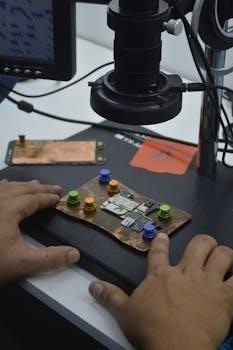The Hayward Aqua Rite system includes a comprehensive diagnostic function, allowing users to monitor its operation. This manual provides an in-depth look at the Aqua Rite and Aqua Rite XL diagnostics, helping you to understand its various readings.
Understanding the Importance of Diagnostics
Understanding the diagnostics of your Hayward Aqua Rite system is crucial for maintaining optimal pool water quality and system performance. The diagnostic features enable you to monitor key parameters such as temperature, cell voltage, and salt levels. By regularly checking these values, you can identify potential issues early, preventing costly repairs and ensuring the longevity of your salt chlorination system. Additionally, diagnostic data helps in fine-tuning the system for efficient chlorine production, ultimately leading to a healthier and more enjoyable swimming experience. These insights also assist in recognizing when professional assistance is needed, avoiding further damage.

Accessing Diagnostic Information
The Hayward Aqua Rite provides a diagnostic button next to the LCD display. Pressing this button sequentially displays various operational parameters, giving you direct access to system data.
Using the Diagnostic Button
To access the diagnostic information on your Hayward Aqua Rite, locate the small diagnostic button typically positioned near the LCD screen. By pressing this button, you can cycle through a series of displays showing vital system data. Each press will advance to the next parameter, allowing you to view information such as pool temperature, cell voltage, and salt levels. This simple button press is the key to monitoring the health and performance of your Aqua Rite system, ensuring it operates efficiently and effectively.
Interpreting Diagnostic Displays
The Aqua Rite displays several parameters sequentially, including pool temperature, cell voltage, and salt level. Understanding these values is essential for effective system maintenance and troubleshooting.
Common Display Parameters
The Hayward Aqua Rite system displays several key parameters. Pool temperature is shown in either Fahrenheit or Celsius. Cell voltage typically ranges from 22.0 to 25.0 volts during chlorine production, or 30-35V when not producing. The system also displays the salt level, which is crucial for proper operation. Other parameters include the desired output percentage, cell type, and software revision. Sequential presses of the diagnostic button cycle through these parameters. Understanding these readings is vital for maintaining your system’s performance. Additionally, some displays may show error codes that require attention.
Troubleshooting Common Issues
Troubleshooting the Hayward Aqua Rite often involves addressing error codes and LED indicators. These signals can help pinpoint issues like low salt levels, cell malfunctions, or system errors, aiding in quick resolution.
Addressing Error Codes and LED Indicators
The Hayward Aqua Rite system uses error codes and LED indicators to communicate issues. For example, a flashing “Inspect Cell” LED, especially with sufficient salt, may signify the 500-hour timer has expired, requiring cleaning and reset. Similarly, the “Check Salt” light indicates a problem with the salt level reading. Understanding these signals is crucial for effective troubleshooting. Diagnostic menus can provide further detail, such as cell voltage and temperature which help identify problems beyond simple error codes. Some issues may be related to incorrect cell types being configured within the system.

Salt Level and Cell Function
Maintaining the correct salt level is vital for optimal cell function. Readings should be within the recommended range, typically around 2700-3400 ppm. Adjustments are needed if levels are outside this range.
Salt Level Readings and Adjustments
The Aqua Rite system displays both average and instant salt readings. To correct a reading, start with the average salt reading, then push the diagnostic button once to get to the temperature display. After this, the system will settle back to the default reading, reflecting the new average salt level. If the salt level is low, you’ll need to add more salt to your pool. If the salt level is too high, you will need to drain some of the pool water and add fresh water. Make sure to add salt or water gradually, and allow the system time to adjust.
Cell Inspection and Cleaning
Regular cell inspection and cleaning are crucial for optimal performance. If the “Inspect Cell” LED is flashing, it’s time to check and clean the cell, following the specific procedure.
Procedure for Cleaning the Cell
To clean the Hayward Aqua Rite cell, first, power off the system. Then, carefully disconnect the cell from the plumbing. Inspect the plates for calcium buildup. If found, use a mild acid solution, such as diluted muriatic acid, soaking the cell until the calcium dissolves. After soaking, rinse thoroughly with water, ensuring all acid is removed. Reinstall the cell, making sure to properly reconnect it to the system. Finally, power the system back on. Note⁚ Always wear protective gear when handling chemicals.

Resetting Timers and Settings
The Hayward Aqua Rite system includes a 500-hour timer that needs resetting after cell cleaning. Resetting this timer ensures accurate monitoring and proper system function.
Resetting 500-Hour Timer
When the “Inspect Cell” LED flashes and the salt level is adequate, the 500-hour timer has been exceeded. This timer indicates the need for cell inspection and cleaning. After cleaning, reset the timer by pressing the diagnostic button for 3-5 seconds. This action restarts the timer for another 500 hours of operation, ensuring the system prompts you when maintenance is due. It’s a crucial step in maintaining your Aqua Rite system’s performance, and it should be performed after every cell cleaning.
Understanding Cell Type and Configuration
Correct cell selection in diagnostics is crucial for proper function. The system needs to be set to match your specific T-CELL model. Incorrect settings may cause errors and system malfunctions.
Ensuring Correct Cell Selection
The Aqua Rite system offers various settings to accommodate different T-Cell models. It’s important to verify that the control is configured for your specific cell type, such as TCELL9 or TCELL15. Selecting the wrong cell type can lead to inaccurate readings and system errors. Some systems may display AL codes, where AL-0 indicates Aqua Rite, while other codes represent different cell types like Aquatrol. Therefore, always double-check the settings and refer to your system’s manual for the proper cell selection procedure to ensure optimal performance and avoid misinterpretations of fault codes.

Seeking Professional Help
If troubleshooting steps fail, or you encounter unresponsive buttons or persistent errors, consult a pool service expert. They can provide further diagnostics and repairs for your Hayward Aqua Rite system.
When to Consult a Pool Service Expert
If the diagnostic displays indicate persistent error codes that you cannot resolve, or if the system’s buttons are unresponsive, it is time to seek professional help. Issues like a malfunctioning motherboard or incorrect cell type settings might require specialized knowledge. Similarly, if you suspect a high voltage electrocution hazard, do not attempt repairs yourself, contact an expert immediately. Pool and spa professionals can provide accurate diagnostics and ensure your Hayward Aqua Rite system is running safely and efficiently. Ignoring complex problems can lead to further damage and costly repairs.